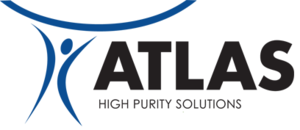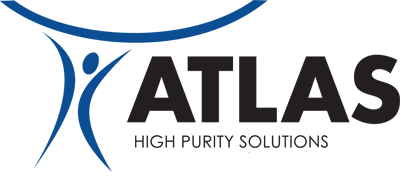For certain applications, electrodeionization (EDI) can be an appopriate substitute for mixed bed ion exchange vessels.
Atlas and Pure Flow connected with Cameron Chambers from GE Osmonics for a discussion on electrodeionization. We discussed a number of different topics including: a general overview of the technology, performance specifications, comparison to service deionization, the nature of the competitive landscape, and where EDI is headed.
Atlas & Pure Flow: Can you give us a brief background on how EDI works?
Cam Chambers: EDI stands for electrodeionization. It basically takes the place of a mixed bed ion exchange vessels. It is fed with high quality water already, for instance from an RO, and is polished up to greater than 16 megohm quality. That's basically equivalent to around 5 ppb of total dissolved solids.
The way that EDI works is that you're passing electrical current through a stack, and within that stack there are anion exchange membranes, cation exchange membranes, and both anion and cation resin. Under the influence of the electrical current, all of the ions, including weakly ionized species such as silica and boron, migrate towards to their respective cathode or the anode. They migrate out of the product water and into a concentrated stream. That's how it operates and purifies your product water.
Atlas & Pure Flow: You mentioned the resistivity performance of EDI and that typically you see EDI performing in the 16 megaohm plus range. Could you elaborate on some of the other key quality metrics, maybe total organic carbon (TOC)?
CC: TOC typically does not get removed by mixed bed or EDI. The reason why TOC tends not to be removed is because its does not to have a charge on it. And if it does have a charge, it typically will get rejected by the RO up-front. So what we usually say is with EDI technology, it neither removes or adds TOC into the water.
From that perspective, it's not a good technology to be used to remove TOC. To make sure that the TOC is minimal, we purify the water within the stack when we're manufacturing it. We rinse it out with high purity water, as well. We want to make sure that there's no TOC, or anything similar, coming off the resin within the stacks.
A big concern for power generation is silica removal. Typically, on a higher pressure steam boiler, you're looking at less than 10 ppb of silica going in. Usually to get to that less than 10 ppb silica, you're going to be looking at less than half a ppm, or 500 ppb of silica going into the cell stacks.
The biggest concern when designing an E-Cell system or an EDI system is high hardness. Just because of the chemistry within the layers of the ion exchange membranes, it is very susceptible to hardness. Usually, you want to see less than 1 ppm as calcium carbonate, total hardness, going into your EDI stack.
The number one reason why EDI stacks have poor performance is CO2, and that's the reason why people typically look at conductivity or resistivity, (typically, conductivity), coming off of their RO system. Very few people actually look at what the CO2 is, coming out of an RO system. The issue there is that the CO2 loads the anion resin within the EDI stack, but it doesn't show up as conductivity. You can potentially have a double pass RO system, feeding an E-Cell at 2 microsiemens, and going through the EDI, and it's coming out at only 1 microsiemen. That’s because the amount of CO2 loading is actually overloading the anion resin, and so you're unable to remove everything else out of the water.
Atlas & Pure Flow: And how do you mitigate that in terms of your pretreatment?
CC: The main way of mitigating CO2 is adding caustic. If you don't add caustic, your pH drops between 1 and 1.5 points across the RO membranes. If you're feeding neutral water (pH of 7) and it's going across an RO membrane, or through an RO membrane, you're typically coming out at 5.5 to a pH of 6. At that rate, you start to add a lot more CO2 in the water. You're converting your alkalinity (and bicarbonate and carbonate) over into CO2.
What you want to do is you want to raise your pH to the point where it's mainly carbonate and bicarbonate, and that it's getting rejected by the RO membrane.
One other option is a forced draft de-carbonator. With that type of technology you would actually drop the pH as far as you wanted to in front of the RO. You would let the majority of the bicarbonate and carbonate convert over to CO2. Then you basically have a large fan and tower that blows air through and up the tower as water is trickling down the tower. As a result, you're blowing off the CO2. Then a the third technology that you could potentially use is a membrane de-gasifier where you are basically drawing the CO2 out of the water through a membrane.
Atlas & Pure Flow: Okay, got it. We definitely see that issue in the field at Atlas High Purity Solutions and Pure Flow quite frequently with rapid exhaustion of service deionization tanks in the field, and use some of the same tools to address that too.
I want to pivot to your perspectives on the Osmonics E-Cell technology, versus other technologies out there. Could you give a quick summary of some of the common industries served by EDI that you've encountered in the field? And then also maybe some uncommon applications that you think would be good for people to know about, that perhaps are less common applications for EDI.
CC: The three main types of applications are pharmaceutical, power, and microelectronics. Basically, anywhere that requires a high quality, high purity water. Those are three main areas that we see EDI being used. Above and beyond that, I've seen systems going in for large caustic facilities, where they're trying to produce some very high-end caustic.
Atlas & Pure Flow: We've talked a little bit about some of the advantages of EDI versus SDI, and it's obvious that there are advantages from a service perspective. However, the trade-off clearly is cost. Are there specific flow rates that you think that EDI is particularly applicable for, or flow rates combined with certain operating environments. (For instance, zero downtime required, etc.) Is there really a sweet spot for EDI in terms of flow?
CC: Pharmaceutical applications are slightly different than power and microelectronics. For pharmaceutical applications, you see flow rates with EDI down to half a gpm, and all the way up to 50 gpm or more.
For power and microelectronics flow rates range from 40 gpm all the way up to 700 gpm. That's because you're now competing with regenerated vs in-place mixed beds, and cation-anion systems. For flow rates in that range, the E-Cell has a smaller footprint. It also allows for replacement of a single element or a single module. You can do that without taking down a third of your total flow rate for a long period of time.
The other big area for EDI is where caustic and acid costs have started to climb, or it's really hard to get that chemicals on site. If it's a remote location, you tend to see EDI, and that flow rate range can then be extended out, versus mixed bed technology.
Also, with an EDI, your recovery is typically between 90% and 96%. The water that gets rejected can be reused in a number of different applications because it's pretty high purity water. It's probably better, and higher quality water, than what you're feeding into your RO. So, you could put that water into a cooling tower, or some other reuse application.
Atlas & Pure Flow: Can you discuss some of the competing technologies out there? Clearly, at Osmonics, you guys are leading with the E-Cell technology, which we've had great experience with. Is there much of a technology difference out there, between major players?
CC: Within North America, there are really four main manufacturers of EDI. One is GE E-Cell, one is Ionpure, and their technologies are very similar performance-wise. Another company is SnowPure, and their stacks are slightly different in that they have what is called a thin concentrate chamber. There's no resin in that chamber, so they use voltage to really drive the amperage across those concentrate chambers. They tend to have to operate at a slightly higher voltage than say E-Cell, and they have issues being fed with a double pass RO. If you have too good a quality water, it becomes a lot less effective, because there's low conductivity in their concentrate stream. So they sometimes have to inject a brine solution into the concentrate stream.
All three: E-Cell, Ionpure, and SnowPure, are all once-through designs. Basically, there's no concentrate recirculation. Hence, the concentrate stream goes through once, and then goes to drain. The fourth technology is from Dow. It's a spiral wound module. It's vertical. It can use concentrate recirculation depending on the system and the operation.
Those are the four main competitors.
Atlas & Pure Flow: One of the things we hear all the time as a service organization is, “Don't you guys feel like EDI is going to threaten your service deionization business?"
Much of our core business has flow rates between 1 GPM and 40 GPM with 18+ megohm quality requirements, which is likely why EDI hasn’t started to replace SDI for Atlas and Pure Flow.
What are your thoughts on whether EDI will eventually replace service deionization? Is it headed that way, or do you think there's always going to be a place for service DI?
Atlas & Pure Flow: I think that there's always going to be a place for service DI. I think there is definitely overlap in some applications and in some flow rates, but I also think that there's a time and a place where service DI definitely makes more sense. Like you said, the flow rates in the 1 to 40 gpm, that's a great area for service DI. Getting above that, the 40 gpm, that's probably where you would start to see conversion over to EDI or E-Cell.
I also look at it as service DI makes sense within a specific distance range: is it 200 km from your facility or more? At some point, it is not economical for you to be trucking back and forth SDI bottles, and so there's the potential for using E-Cell, or EDI technology, to extend your service range. You may still have to go out and review or service the site once a quarter, but it becomes a lot less arduous on your service team. That's one way that I would look at EDI and service DI working together.
Atlas & Pure Flow: Cam, thanks for your time. Is there anything you would want to add to summarize our discussion?
CC: No. I think EDI is a great technology. It's become simpler to use, with the removal of concentrate recirculation. It's moving further and further ahead.
___
Atlas High Purity Solutions has been designing, installing, and servicing high purity water systems for more than thirty years, and is the leading provider of reverse osmosis and DI water solutions in the northeastern United States.



